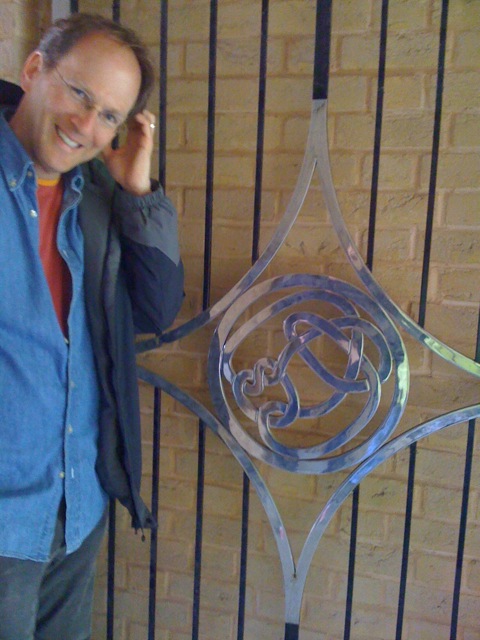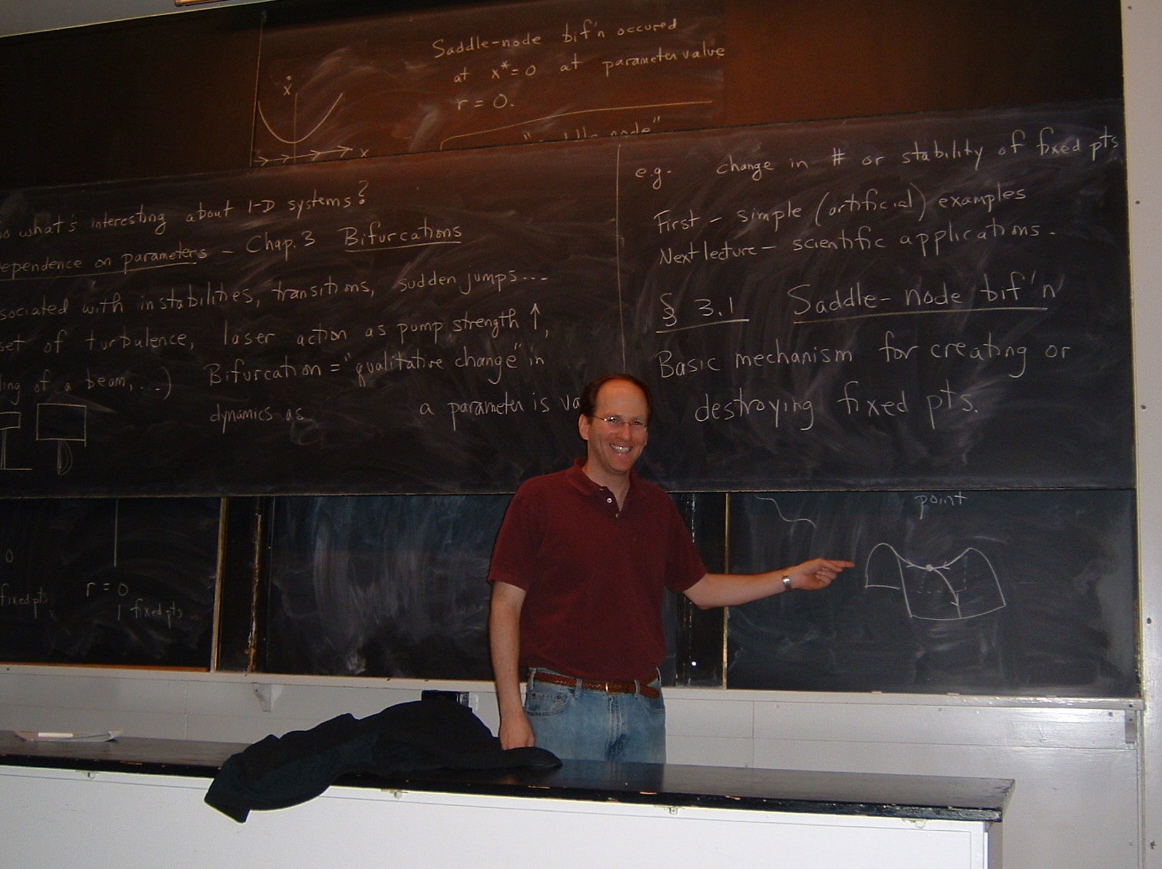SWARMS
OF
SYNCHRONOUSLY
FLASHING
FIREFLIES
Poetry? Well, yes, and also one of the ways Applied Mathematician Steven Strogatz describes his work.
The author of Sync: How Order Emerges from Chaos in the Universe, Nature, and Daily Life and a frequent contributor to Radio Lab and The New York Times, Strogatz devotes a good deal of his time to helping people understand the beauty of mathematics.
I live in the world of math applied to nature. For me, it’s a two-way street where nature is an inspiration for math problems [and math can be done] in the service of trying to understand nature.
At the beginning of my career I was fascinated by mathematical biology and worked on a variety of problems, including the geometry of supercoiled DNA, the dynamics of the human sleep-wake cycle, the topology of three-dimensional chemical waves, and the collective behavior of biological oscillators, such as swarms of synchronously flashing fireflies.
Strogatz, whose words you just read, uses math to explore the world, life, and their rhythms. What routes do people in New York City take when riding in taxi cabs and how might pollution and other costs might be reduced if they shared rides? Why/when/how do groups of fireflies end up shining their lights at the same time? These are the kinds of questions that guide Strogatz’s work.
As a child living in Torrington, Connecticut, “I always liked school: I liked all kinds of different subjects … math did not stand out to me. Literature was great and I liked science.” In his sophomore year of high school, Steven found himself rather tired of geometry, partly because he had studied it already, in junior high. “I was the kind of student who when I repeated material did worse on it because I wasn’t paying attention: I was bored.”
Eventually, someone suggested that he switch into Richard Johnson’s pre-calculus class. There, he learned about “things like vectors, complex numbers, trigonometry, [and] different complicated things about functions.”

One day in class, Mr. Johnson challenged his students, telling them that the topic they were covering reminded him “‘of a geometry problem about the angle bisectors of a triangle. I’ve never seen any student solve the problem. In fact, I don’t know how to solve it myself.’” Immediately curious, Steven tried to solve the problem that Mr. Johnson posed: If a triangle has two angle bisectors that are congruent (the same length), prove that the triangle must be an isosceles triangle. Many professional mathematicians struggle with this problem, the Steiner-Lehmus theorem. “The more I couldn’t do it, the more curious I became.”
His work on the theorem caused problems in French class. Students took turns conjugating verbs while “I was thinking about the angle bisectors. I thought about the problem pretty much continuously for about half a year.”
Eventually, he called Mr. Johnson and asked if he could show him what he had come up with. That’s how Steven found himself at his math teacher’s kitchen table one Sunday morning, surrounded by the Johnson family and aware that his teacher was still in his pajamas. “Yes, it’s a proof” were the words he had come over to hear … and he heard them and found himself inspired to seek out other difficult problems and work towards other proofs.
“I didn’t know it at the time, but I was doing research. That is what research is: you’re curious or irritated by something; you want to understand it and make up questions.” The Steiner-Lehmus theorem had “got me really curious about math.”
So did an experiment Steven and his fellow students had done in science class the year before. A pendulum is a weight that swings at the end of a string. The students in Robert DiCurcio’s class took pendulums of different lengths, timed 10 swings of the pendulum at each length, and graphed their results. “After maybe four or five dots, I could see a pattern emerging on the graph paper which surprised me very much.” A curve took shape before his eyes, showing how the time for 10 swings depends on the pendulum’s length. “I felt a sudden chill when I realized that the pendulum is following a parabola — that there is an invisible world here that I have suddenly seen.”

He had learned about parabolas in algebra class. “I got a feeling almost like this sense that there’s someone standing behind you and the hairs on the back of your neck start bristling — a creepy feeling, like a presence. Also a feeling of awe — that the pendulum somehow knows algebra.” Here was another reason to pursue the kind of learning that his pre-calculus teacher would inspire him to do. “I started to understand in a flash that the world is ruled by patterns … but some of them are hidden unless you know math.”
“Math underlies the laws of nature: I got captivated by this idea.” Eventually this led to a focus on sleep, which Strogatz studied while working on his doctorate, at Harvard University. “The pendulum is a time-keeper in grandfather clocks” and this “led me into sleep research.”
Human beings have evolved to sleep at night and be awake during the day: we are “diurnal.” And, like many other forms of life on this planet, we have bodies whose systems follow cycles that repeat every 24-25 hours. This is called our “circadian rhythm.” Strogatz explains this as follows: “We live on a planet that rotates on its axis once a day. Somehow that basic fact of life on Earth is built into the deepest part of our biology.”
But some nurses, police officers, fire-fighters, submarine operators, and people in many other professions must stay awake at night and sleep during the day, following a “nocturnal” schedule. “What happens when people live on strange schedules?” wondered Strogatz. How do unusual sleep schedules affect people’s circadian rhythms?
NASA was also interested in this question in the 1960s, while preparing to send astronauts into outer space, where the daily schedule set for us on Earth by the Sun would not apply. “Would the astronauts get very sick? Be able to survive? Be fine?” Scientists in the ‘60s found ways of imitating the outer space experience. They sent people (often themselves) deep into caves, where they could not tell when the sun was up or when it was night. In those caves, “it’s dark and there are rodents running around and bats dropping guano. Brave scientists … went into these caves and lived there for up to six months.”
In the 1970s, scientists created laboratories with no windows or clocks, sound-proofing them so that people living inside the labs could not hear sounds that might tell them what time it was or affect their sleep and other cycles. The cave experiments and these, based in labs, helped them learn about chronobiology, the interactions of time and life. The longer people stayed in these sunlight-free places, the more “an extremely weird thing which nobody expected” happened. Strogatz and other scientists found that about a third of the people in these experiments “start having extremely long days,” not 24-hour cycles of sleeping and waking but 36-to-50-hour days. In other words, the time between one wake-up and the next, normally 24 hours and shaped by the amount of time it takes the Earth to rotate, became longer and longer. And “what’s bizarre is that they don’t know it.” “Even though they’re awake twice as long as normal, they still only ask for three meals and they don’t eat double. They lose weight and this was the cause of some concern.”
Being away from their normal routines and unaware of the passage of day and night changed some of the rhythms of people’s bodies, but not others. Our body temperature changes each day, rising and falling about a half of a degree. This pattern and the pattern set by the level of the hormone cortisol in our blood, which also follows a day-to-day schedule, continued on at what scientists have found to be our body’s natural cycle: a 24.2-hour day. “We have cells that are mimicking the speed of the Earth: there’s this deep knowledge of the planet built into our biology.” Strogatz explains that “my PhD was about these rhythms in our bodies and the internal desynchronization that occurs when our sleep-wake cycle runs at a different rhythm than our circadian clock.”
Those fireflies he described so poetically at the beginning of this article also live according to rhythms. Strogatz finds the way swarms of fireflies flash in sync, at the same times, fascinating. People once thought that what appears to be simultaneous flashing of light was just a trick of the human imagination or that the bugs might be reacting to events like lightning or thunder. But “[t]he thinking now is that individual fireflies are able not only to emit flashes but also to respond to the flashes of others—they adjust their own timers.”
Applied Mathematician Strogatz studies the math behind these kinds of simultaneous events, from the fireflies to crickets who chirp in unison to the human heart. Pacemaker cells in our hearts fire in unison, controlling the pulse that keeps us alive. That math that young Steven discovered to be behind “the laws of nature” is vital, as well as beautiful.


